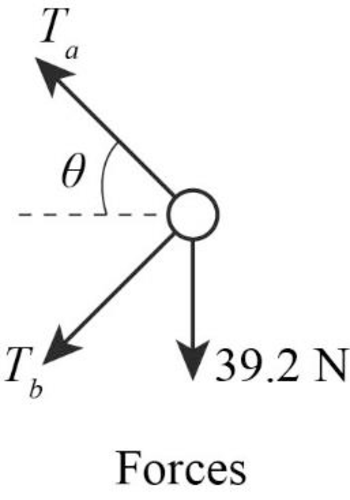
Why is the following situation impossible? The object of mass m = 4.00 kg in Figure P5.18 is attached to a vertical rod by two strings of length ℓ = 2.00 m. The strings are attached to the rod at points a distance d = 3.00 m apart. The object rotates in a horizontal circle at a constant speed of v = 3.00 m/s, and the strings remain taut. The rod rotates along with the object so that the strings do not wrap on to the rod. What If? Could this situation be possible on another planet?

The reason why the situation shown in Figure P5.18 is impossible, and whether this situation is be possible on another planet.
Answer to Problem 18P
The situation shown in Figure P5.18 is impossible, because the speed of the object is too small, the lower string is require that act like a rod and push rather than like a string and pull. This situation is only possible when
Explanation of Solution
The free body diagram of the system is shown Figure.

Write the expression for force due to gravity.
Here,
A centripetal force is needed to keep the object in the circular motion, this is equal to the force in the horizontal direction.
Here,
From the free body diagram, write the expression for net force in the
Here,
Equate equation (II) and (III).
Write the expression for force in the
Since there is no acceleration in the
From the free body diagram, write the expression for net force in the
Equate equation (V) and (VI).
Add equation (IV) and (VII).
Conclusion:
The angle
`
The radius of the orbit can be found as follows,
Substitute,
Substitute,
It indicates that lower string pushes rather than pulls.
Substitute,
Substitute,
This is possible only when
Therefore, the situation shown in Figure P5.18 is impossible, because the speed of the object is too small, the lower string is require that act like a rod and push rather than like a string and pull. This situation is only possible when
Want to see more full solutions like this?
Chapter 5 Solutions
Principles of Physics: A Calculus-Based Text
- No chatgpt pls will upvotearrow_forwardair is pushed steadily though a forced air pipe at a steady speed of 4.0 m/s. the pipe measures 56 cm by 22 cm. how fast will air move though a narrower portion of the pipe that is also rectangular and measures 32 cm by 22 cmarrow_forwardNo chatgpt pls will upvotearrow_forward
- 13.87 ... Interplanetary Navigation. The most efficient way to send a spacecraft from the earth to another planet is by using a Hohmann transfer orbit (Fig. P13.87). If the orbits of the departure and destination planets are circular, the Hohmann transfer orbit is an elliptical orbit whose perihelion and aphelion are tangent to the orbits of the two planets. The rockets are fired briefly at the depar- ture planet to put the spacecraft into the transfer orbit; the spacecraft then coasts until it reaches the destination planet. The rockets are then fired again to put the spacecraft into the same orbit about the sun as the destination planet. (a) For a flight from earth to Mars, in what direction must the rockets be fired at the earth and at Mars: in the direction of motion, or opposite the direction of motion? What about for a flight from Mars to the earth? (b) How long does a one- way trip from the the earth to Mars take, between the firings of the rockets? (c) To reach Mars from the…arrow_forwardNo chatgpt pls will upvotearrow_forwarda cubic foot of argon at 20 degrees celsius is isentropically compressed from 1 atm to 425 KPa. What is the new temperature and density?arrow_forward
- Calculate the variance of the calculated accelerations. The free fall height was 1753 mm. The measured release and catch times were: 222.22 800.00 61.11 641.67 0.00 588.89 11.11 588.89 8.33 588.89 11.11 588.89 5.56 586.11 2.78 583.33 Give in the answer window the calculated repeated experiment variance in m/s2.arrow_forwardNo chatgpt pls will upvotearrow_forwardCan you help me solve the questions pleasearrow_forward
- Can you help me solve these questions please so i can see how to do itarrow_forwardHow can i solve this if n1 (refractive index of gas) and n2 (refractive index of plastic) is not known. And the brewsters angle isn't knownarrow_forward2. Consider the situation described in problem 1 where light emerges horizontally from ground level. Take k = 0.0020 m' and no = 1.0001 and find at which horizontal distance, x, the ray reaches a height of y = 1.5 m.arrow_forward
 Physics for Scientists and Engineers with Modern ...PhysicsISBN:9781337553292Author:Raymond A. Serway, John W. JewettPublisher:Cengage Learning
Physics for Scientists and Engineers with Modern ...PhysicsISBN:9781337553292Author:Raymond A. Serway, John W. JewettPublisher:Cengage Learning Principles of Physics: A Calculus-Based TextPhysicsISBN:9781133104261Author:Raymond A. Serway, John W. JewettPublisher:Cengage Learning
Principles of Physics: A Calculus-Based TextPhysicsISBN:9781133104261Author:Raymond A. Serway, John W. JewettPublisher:Cengage Learning

